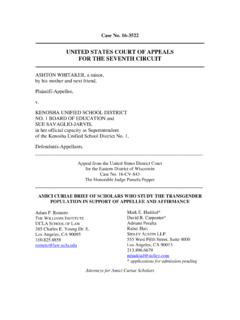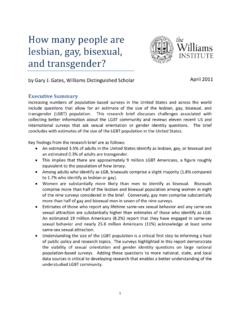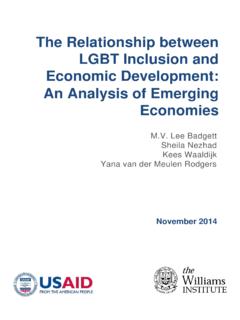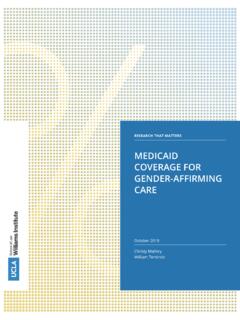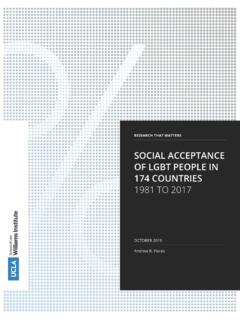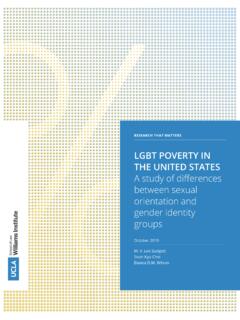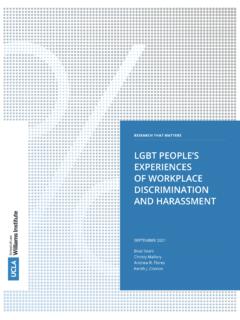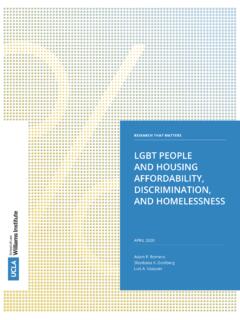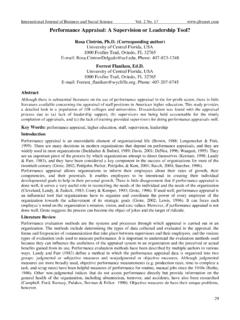Transcription of Suicide Attempts among Transgender and Gender Non ...
1 Suicide Attempts among Transgender and Gender Non-Conforming Adults FINDINGS OF THE. NATIONAL Transgender . DISCRIMINATION SURVEY. Ann P. Haas, and Philip L. Rodgers, , American Foundation for Suicide Prevention Jody L. Herman, Williams Institute, UCLA School of Law January 2014. EXECUTIVE SUMMARY. The prevalence of Suicide Attempts among respondents Respondents who experienced rejection by family and to the National Transgender Discrimination Survey friends, discrimination, victimization, or violence had (NTDS), conducted by the National Gay and Lesbian elevated prevalence of Suicide Attempts , such as those Task Force and National Center for Transgender Equality, who experienced the following: is 41 percent, which vastly exceeds the percent of Family chose not to speak/spend time with them: 57%. the overall population who report a lifetime Suicide Discrimination, victimization, or violence at school, attempt, and is also higher than the 10-20 percent at work, and when accessing health care of lesbian, gay and bisexual adults who report ever attempting Suicide .
2 Much remains to be learned about Harassed or bullied at school (any level): 50-54%. underlying factors and which groups within the diverse Experienced discrimination or harassment at population of Transgender and Gender non-conforming work: 50-59%. people are most at risk. Doctor or health care provider refused to treat them: 60%. In the present study, we sought to increase Suffered physical or sexual violence: understanding of suicidal behavior among Transgender and Gender non-conforming people through an in-depth At work: 64-65%. analysis of NTDS data. The specific aims of our analysis At school (any level): 63-78%. were to identify the key characteristics and experiences Discrimination, victimization, or violence by law associated with lifetime Suicide Attempts in the NTDS enforcement sample as a whole, and to examine how lifetime Suicide Disrespected or harassed by law enforcement Attempts vary among different groups of Transgender officers: 57-61%.
3 And Gender non-conforming people. Suffered physical or sexual violence: By law Key findings of this report include the following: enforcement officers: 60-70. Experienced homelessness: 69%. Suicide Attempts among trans men (46%) and trans women (42%) were slightly higher than the full sample (41%). Cross-dressers assigned male at birth Overall, the most striking finding of our analysis was the have the lowest reported prevalence of Suicide Attempts among Gender identity exceptionally high prevalence of lifetime Suicide Attempts reported groups (21%). by NTDS respondents across all demographics and experiences.. Analysis of other demographic variables found prevalence of Suicide Attempts was highest among those who are younger (18 to Overall, the most striking finding of our analysis was 24: 45%), multiracial (54%) and American Indian or the exceptionally high prevalence of lifetime Suicide Alaska Native (56%), have lower levels of educational Attempts reported by NTDS respondents across attainment (high school or less: 48-49%), and have all demographics and experiences.
4 Based on prior lower annual household income (less than $10,000: research and the findings of this report, we find that 54%). mental health factors and experiences of harassment, Prevalence of Suicide Attempts is elevated among discrimination, violence and rejection may interact to those who disclose to everyone that they are produce a marked vulnerability to suicidal behavior in Transgender or Gender -non-conforming (50%) and Transgender and Gender non-conforming individuals. among those that report others can tell always (42%) More research on suicidal behavior among Transgender or most of the time (45%) that they are Transgender and Gender non-conforming people is needed. or Gender non-conforming even if they don't tell them. Respondents who are HIV-positive (51%) and respondents with disabilities (55-65%) also have elevated prevalence of Suicide Attempts . In particular, 65 percent of those with a mental health condition that substantially affects a major life activity reported attempting Suicide .
5 2. INTRODUCTION. Since 2001, over a dozen separate surveys of the present study, we sought to increase understanding Transgender adults in the United States and other of suicidal behavior among Transgender and Gender non- countries have found lifetime Suicide Attempts to be conforming people through an in-depth analysis of data reported by 25-43 percent of respondents (Clements- from the National Transgender Discrimination Survey Nolle et al., 2001; Clements-Nolle et al., 2006; Grant (NTDS), conducted by the National Gay and Lesbian Task et al., 2011; Kenagy, 2005; Maguen & Shipherd, 2010; Force and the National Center for Transgender Equality. Transgender Equality Network Ireland, 2012; Trans PULSE, With over 6,000 respondents, the NTDS is the largest 2010; Whittle et al., 2007; Whittle et al., 2008; Xavier et al., survey of Transgender and Gender non-conforming 2005; Xavier et al., 2007). These figures vastly exceed adults to date.
6 In that sample, 41 percent of respondents the percent of the overall population who report reported ever attempting Suicide (Grant et al., 2011). a lifetime Suicide attempt (Kessler, Borges and Walters, 1999; Nock & Kessler, 2006), and are also higher than The specific aims of our analysis were to identify the key the 10-20 percent of lesbian, gay and bisexual adults who characteristics and experiences associated with lifetime report ever attempting Suicide (Paul et al., 2002). Suicide Attempts in the NTDS sample as a whole, and to examine how lifetime Suicide Attempts vary among While these surveys suggest an unparalleled level of different groups of Transgender and Gender non- suicidal behavior among Transgender adults, much conforming people. In this report, we present our findings, remains to be learned about underlying factors and which discuss their implications, and conclude by describing groups within this diverse population are most at risk.
7 In considerations and needs for future research. METHODS AND LIMITATIONS. The NTDS was launched in fall 2008 and was distributed for Suicide , or engaging in self-harm behavior without online and on paper through over 900 organizations that the intent to die (Bongiovi-Garcia et al., 2009). The were known venues for contact with the Transgender National Comorbity Survey, a nationally representative community throughout the United States. Details of survey, found that probing for intent to die through the survey instrument, methods and procedures have in-person interviews reduced the prevalence of lifetime previously been described (Grant et al., 2011). In brief, Suicide Attempts from percent to percent of the responses were obtained from 6,456 self-identified adult sample (Kessler et al., 1999; Nock & Kessler, 2006). Transgender and Gender non-conforming adults aged 18 Without such probes, we were unable to determine the and over.
8 History of lifetime Suicide attempt was among extent to which the 41 percent of NTDS participants the many outcomes covered in the 70-item survey. who reported ever attempting Suicide may overestimate The analysis of the NTDS data presented in this paper the actual prevalence of Attempts in the sample. In is mainly descriptive. Where appropriate, Pearson's addition, the analysis was limited due to a lack of chi-square tests of independence were conducted to follow-up questions asked of respondents who reported assess whether lifetime Suicide Attempts were related having attempted Suicide about such things as age and to a variety of characteristics and experiences of survey Transgender / Gender non-conforming status at the time respondents. of the attempt. While the NTDS provides a wealth of information Second, the survey did not directly explore mental about the experiences of Transgender and Gender health status and history, which have been identified non-conforming people, the survey instrument and as important risk factors for both attempted and methodology posed some limitations for this study.
9 Completed Suicide in the general population (Lasage, First, the NTDS questionnaire included only a single Boyer, Grunberg, Vanier, Morissett et al., 1994; Suominen, item about suicidal behavior that asked, Have you ever Henrikssen, Suokas, Isometsa, Ostamo, et al., 1996;. attempted Suicide ? with dichotomized responses of Harris & Barraclough, 1997; Bertolote & Fleischmann, Yes/No. Researchers have found that using this question 2002; Nock, Hwang, Sampson, & Kessler, 2010). Further, alone in surveys can inflate the percentage of affirmative research has shown that the impact of adverse life responses, since some respondents may use it to events, such as being attacked or raped, is most severe communicate self-harm behavior that is not a Suicide among people with co-existing mood, anxiety and other attempt, such as seriously considering Suicide , planning mental disorders (Breslau, Davis, Andreski, & Peterson, 3. Methods - continued 1991; Kendler, Kardowski, & Presco, 1999).
10 The lack of data to be the best available proxy measure of Suicide systematic mental health information in the NTDS data death. Data from the population at large, however, significantly limited our ability to identify the pathways show clear demographic differences between Suicide to suicidal behavior among the respondents. attempters and those who die by Suicide . While almost 80 percent of all Suicide deaths occur among males, Third, since the NTDS utilized convenience sampling, it about 75 percent of Suicide Attempts are made by is unclear how representative the respondents are of the females. Adolescents, who overall have a relatively low overall Transgender / Gender non-conforming adult Suicide rate of about 7 per 100,000 people, account for population. Further, the survey's focus on discrimination a substantial proportion of Suicide Attempts , making may have resulted in wider participation by persons perhaps 100 or more Attempts for every Suicide death.
